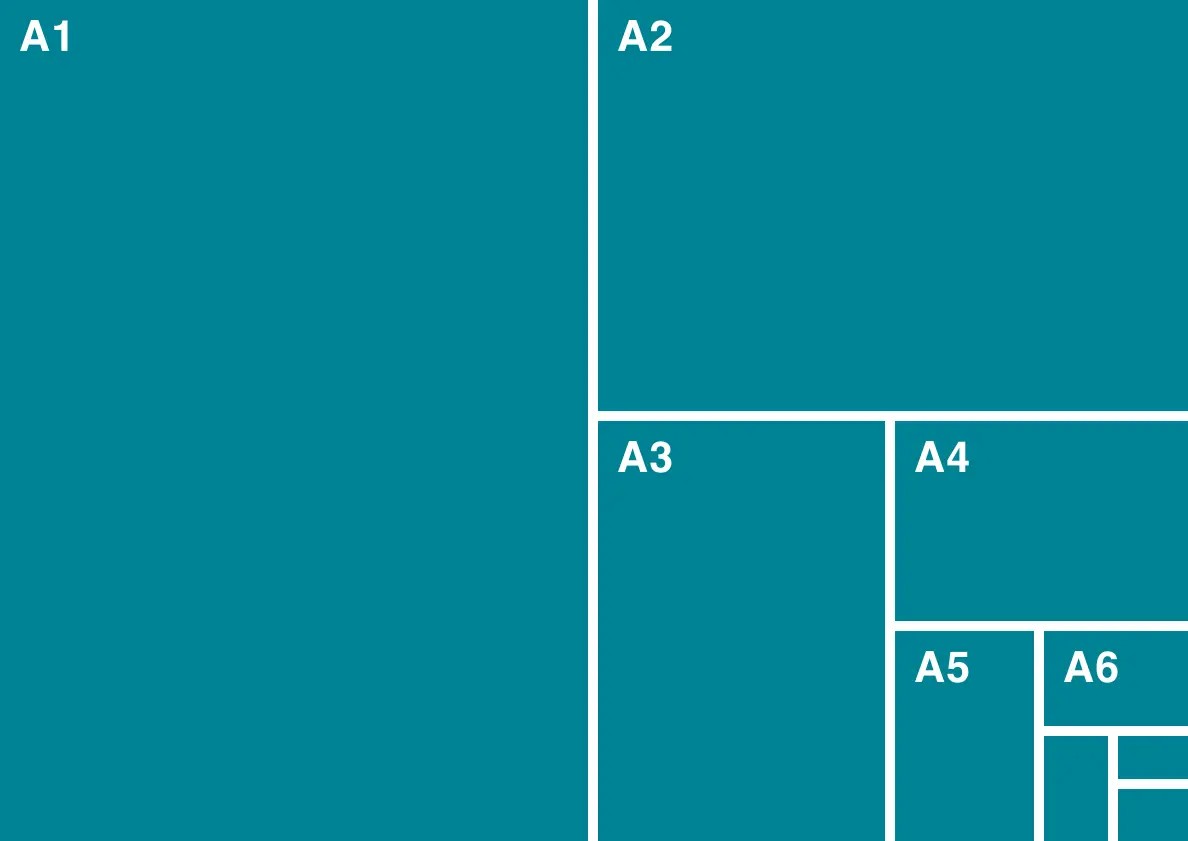Understanding paper sizes can be confusing, especially when faced with designations like A3 and A4. This guide clarifies the differences between these common sizes and explores their various uses. We’ll delve into the dimensions of A3 versus A4, compare them to other standard sizes, and provide a handy chart for quick reference.
Decoding the A-Series Paper Sizes
The “A” in A3 and A4 signifies the ISO 216 international paper size standard, widely adopted across the globe except in North America. This system cleverly uses a 1:√2 aspect ratio. This unique proportion allows each size to be precisely half the area of the next larger size when folded in half along its longer side. For instance, folding A3 in half creates A4.
 Diagram of A-class paper sizes in a grid to illustrate that when each size is folded in half, it creates the next smallest size
Diagram of A-class paper sizes in a grid to illustrate that when each size is folded in half, it creates the next smallest size
A3 vs. A4: Dimensions and Applications
The key difference between A3 and A4 lies in their dimensions:
-
A4 Paper Size: Measures 210 x 297 millimeters (8.3 x 11.7 inches). This is the standard size for everyday printing tasks, including documents, letters, and stationery. Most home and office printers are designed to handle A4 paper.
-
A3 Paper Size: Measures 297 x 420 millimeters (11.7 x 16.5 inches). Noticeably larger than A4, A3 is twice its area. This size is ideal for larger format materials such as posters, presentations, spreadsheets requiring more space, large tables or charts, and architectural drawings. While not as common in home printers, many business-oriented inkjet printers and dedicated wide-format printers support A3 printing.
Exploring Other Common A-Sizes
The A-series extends beyond A3 and A4, ranging from the expansive A0 to the diminutive A10. Here’s a brief overview:
-
A0-A2: These large formats are typically used for posters, banners, and large-scale drawings. A0 is the largest, with dimensions of 841 x 1189 mm.
-
A5-A7: These smaller sizes are suitable for flyers, leaflets, notebooks, and postcards. A5 is half the size of A4, while A6 and A7 are progressively smaller.
-
A8-A10: These tiny sizes are less frequently used but can be found in small notepads, business cards, and labels.
A-Series Paper Size Chart: A Quick Reference
This table provides a complete overview of A-series paper dimensions in millimeters, centimeters, and inches:
| Paper Size | Millimeters (mm) | Centimeters (cm) | Inches (in) |
|---|---|---|---|
| A0 | 841 x 1189 | 84.1 x 118.9 | 33.1 x 46.8 |
| A1 | 594 x 841 | 59.4 x 84.1 | 23.4 x 33.1 |
| A2 | 420 x 594 | 42.0 x 59.4 | 16.5 x 23.4 |
| A3 | 297 x 420 | 29.7 x 42.0 | 11.7 x 16.5 |
| A4 | 210 x 297 | 21.0 x 29.7 | 8.3 x 11.7 |
| A5 | 148 x 210 | 14.8 x 21.0 | 5.8 x 8.3 |
| A6 | 105 x 148 | 10.5 x 14.8 | 4.1 x 5.8 |
| A7 | 74 x 105 | 7.4 x 10.5 | 2.9 x 4.1 |
| A8 | 52 x 74 | 5.2 x 7.4 | 2.0 x 2.9 |
| A9 | 37 x 52 | 3.7 x 5.2 | 1.5 x 2.0 |
| A10 | 26 x 37 | 2.6 x 3.7 | 1.0 x 1.5 |
Conclusion
Choosing the right paper size depends on your specific needs. Understanding the relationship between sizes, especially the doubling and halving of area within the A-series, simplifies the selection process. This guide provides a clear comparison of A3 and A4, offering a solid foundation for making informed printing decisions.
